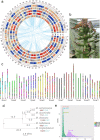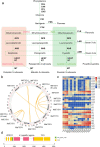The Musa troglodytarum L. genome provides insights into the mechanism of non-climacteric behaviour and enrichment of carotenoids
- PMID: 36002843
- PMCID: PMC9400310
- DOI: 10.1186/s12915-022-01391-3
The Musa troglodytarum L. genome provides insights into the mechanism of non-climacteric behaviour and enrichment of carotenoids
Abstract
Background: Karat (Musa troglodytarum L.) is an autotriploid Fe'i banana of the Australimusa section. Karat was domesticated independently in the Pacific region, and karat fruit are characterized by a pink sap, a deep yellow-orange flesh colour, and an abundance of β-carotene. Karat fruit showed non-climacteric behaviour, with an approximately 215-day bunch filling time. These features make karat a valuable genetic resource for studying the mechanisms underlying fruit development and ripening and carotenoid biosynthesis.
Results: Here, we report the genome of M. troglodytarum, which has a total length of 603 Mb and contains 37,577 predicted protein-coding genes. After divergence from the most recent common ancestors, M. troglodytarum (T genome) has experienced fusion of ancestral chromosomes 8 and 9 and multiple translocations and inversions, unlike the high synteny with few rearrangements found among M. schizocarpa (S genome), M. acuminata (A genome) and M. balbisiana (B genome). Genome microsynteny analysis showed that the triplication of MtSSUIIs due to chromosome rearrangement may lead to the accumulation of carotenoids and ABA in the fruit. The expression of duplicated MtCCD4s is repressed during ripening, leading to the accumulation of α-carotene, β-carotene and phytoene. Due to a long terminal repeat (LTR)-like fragment insertion upstream of MtERF11, karat cannot produce large amounts of ethylene but can produce ABA during ripening. These lead to non-climacteric behaviour and prolonged shelf-life, which contributes to an enrichment of carotenoids and riboflavin.
Conclusions: The high-quality genome of M. troglodytarum revealed the genomic basis of non-climacteric behaviour and enrichment of carotenoids, riboflavin, flavonoids and free galactose and provides valuable resources for further research on banana domestication and breeding and the improvement of nutritional and bioactive qualities.
Keywords: Banana; Carotenoids; Chromosome-level genome; Non-climacteric behaviour.
© 2022. The Author(s).
Conflict of interest statement
The authors declare that they have no competing interests.
Figures






Similar articles
-
High-quality genome assemblies for two Australimusa bananas (Musa spp.) and insights into regulatory mechanisms of superior fiber properties.Plant Commun. 2024 Jan 8;5(1):100681. doi: 10.1016/j.xplc.2023.100681. Epub 2023 Sep 3. Plant Commun. 2024. PMID: 37660253 Free PMC article.
-
The Quest for Golden Bananas: Investigating Carotenoid Regulation in a Fe'i Group Musa Cultivar.J Agric Food Chem. 2016 Apr 27;64(16):3176-85. doi: 10.1021/acs.jafc.5b05740. Epub 2016 Apr 12. J Agric Food Chem. 2016. PMID: 27041343
-
Banana MaSPL16 Modulates Carotenoid Biosynthesis during Fruit Ripening through Activating the Transcription of Lycopene β-Cyclase Genes.J Agric Food Chem. 2020 Feb 5;68(5):1286-1296. doi: 10.1021/acs.jafc.9b07134. Epub 2020 Jan 24. J Agric Food Chem. 2020. PMID: 31891496
-
Regulation of Carotenoid Biosynthesis During Fruit Development.Subcell Biochem. 2016;79:161-98. doi: 10.1007/978-3-319-39126-7_6. Subcell Biochem. 2016. PMID: 27485222 Review.
-
Translating the "Banana Genome" to Delineate Stress Resistance, Dwarfing, Parthenocarpy and Mechanisms of Fruit Ripening.Front Plant Sci. 2016 Oct 26;7:1543. doi: 10.3389/fpls.2016.01543. eCollection 2016. Front Plant Sci. 2016. PMID: 27833619 Free PMC article. Review.
Cited by
-
Shaping the future of bananas: advancing genetic trait regulation and breeding in the postgenomics era.Hortic Res. 2025 Feb 12;12(5):uhaf044. doi: 10.1093/hr/uhaf044. eCollection 2025 May. Hortic Res. 2025. PMID: 40236735 Free PMC article.
-
Chromosome-level genome assemblies of Musa ornata and Musa velutina provide insights into pericarp dehiscence and anthocyanin biosynthesis in banana.Hortic Res. 2024 Mar 14;11(5):uhae079. doi: 10.1093/hr/uhae079. eCollection 2024 May. Hortic Res. 2024. PMID: 38766534 Free PMC article.
-
Telomere-to-telomere haplotype-resolved reference genome reveals subgenome divergence and disease resistance in triploid Cavendish banana.Hortic Res. 2023 Aug 1;10(9):uhad153. doi: 10.1093/hr/uhad153. eCollection 2023 Sep. Hortic Res. 2023. PMID: 37701454 Free PMC article.
-
Identification of annotation artifacts concerning the chalcone synthase (CHS).BMC Res Notes. 2023 Jun 20;16(1):109. doi: 10.1186/s13104-023-06386-z. BMC Res Notes. 2023. PMID: 37340477 Free PMC article.
-
Multi-omics profiling of Nanhaia speciosa and Nanhaia fordii: insights into lectin dynamics, nodulation, and triterpenoid saponin biosynthesis.BMC Biol. 2025 Jul 1;23(1):169. doi: 10.1186/s12915-025-02278-9. BMC Biol. 2025. PMID: 40597146 Free PMC article.
References
-
- De Langhe E, Vrydaghs L, De Maret P, Perrier X, Denham T. Why bananas matter: an introduction to the history of banana domestication. Ethnobot Res Appl. 2009;7:165–177. doi: 10.17348/era.7.0.165-177. - DOI
-
- Englberger L. A community and laboratory-based assessment of natural food sources of vitamin A in the Federated States of Micronesia. Nutrition -- Micronesia (Federated States) 2003.
-
- Englberger L, Schierle J, Marks GC, Fitzgerald MH. Micronesian banana, taro, and other foods: newly recognized sources of provitamin A and other carotenoids. J Food Compos Anal. 2003;16(1):3–19. doi: 10.1016/S0889-1575(02)00133-3. - DOI
-
- Mahabadi N, Bhusal A, Banks SW. Riboflavin Deficiency. 2020. - PubMed
Publication types
MeSH terms
Substances
LinkOut - more resources
Full Text Sources
Miscellaneous

